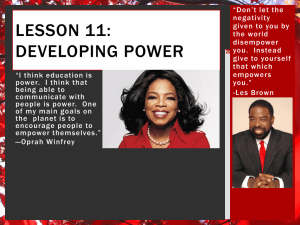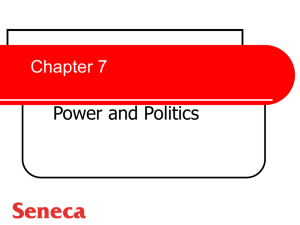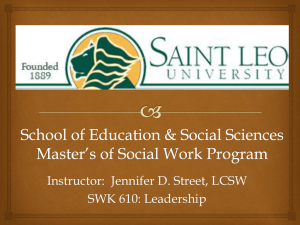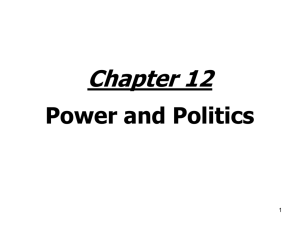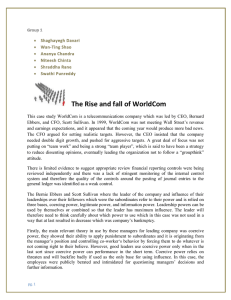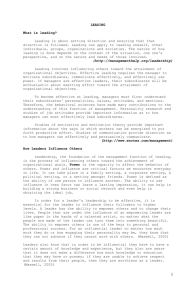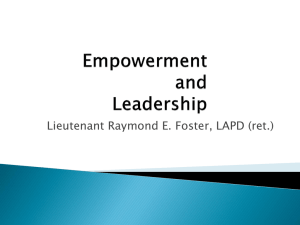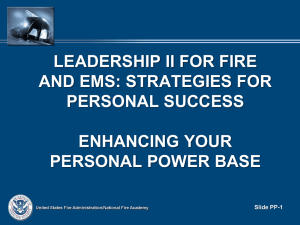File
advertisement
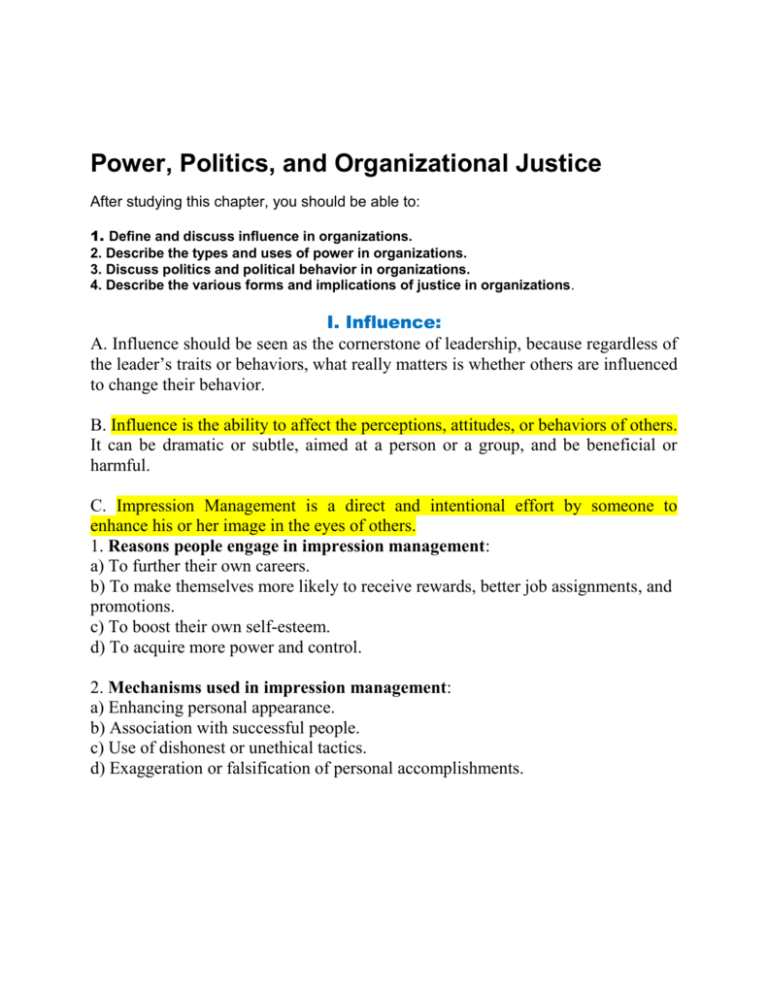
Power, Politics, and Organizational Justice After studying this chapter, you should be able to: 1. Define and discuss influence in organizations. 2. Describe the types and uses of power in organizations. 3. Discuss politics and political behavior in organizations. 4. Describe the various forms and implications of justice in organizations. I. Influence: A. Influence should be seen as the cornerstone of leadership, because regardless of the leader’s traits or behaviors, what really matters is whether others are influenced to change their behavior. B. Influence is the ability to affect the perceptions, attitudes, or behaviors of others. It can be dramatic or subtle, aimed at a person or a group, and be beneficial or harmful. C. Impression Management is a direct and intentional effort by someone to enhance his or her image in the eyes of others. 1. Reasons people engage in impression management: a) To further their own careers. b) To make themselves more likely to receive rewards, better job assignments, and promotions. c) To boost their own self-esteem. d) To acquire more power and control. 2. Mechanisms used in impression management: a) Enhancing personal appearance. b) Association with successful people. c) Use of dishonest or unethical tactics. d) Exaggeration or falsification of personal accomplishments. II. Power in Organizations A. The Nature of Power 1. Power is the potential ability of a person or group to influence another person or group. Power need not be exercised to influence others. Power may reside in individuals or in groups. Influence is the mechanism for affecting others. 2. Power is an important part of organizational life. B. Types of Power Types of power usually are described in terms of bases of power and position power versus personal power. 1. Bases of Power. John R. P. French and Bertram Raven developed a framework for studying five general bases of power in organizational settings. a) Legitimate power is granted by virtue of one’s position in the organization. It is essentially the same as authority and varies from one organization to the next. In highly mechanistic and bureaucratic organizations such as the military, the legitimate power inherent in each position is closely specified, widely known, and strictly followed. In more organic organizations, lines of legitimate power often are blurred. b) Reward power is the extent to which a person controls rewards that another person values. At work, examples of reward include salary increase, promotion, etc. c) Coercive power is the ability to punish or inflict physical or psychological harm on someone else. Coercive power involves considerable costs—notably employee resentment and hostility. d) Expert power relates to the control over expertise, that is, over information. The more important the information and the fewer the alternative sources for acquiring it, the greater the power. Expert power can reside in many places in organizations; it transcends positions and jobs. e) Referent power basically is power through identification. It does not always correlate with formal organizational authority. It often involves trust, similarity, acceptance, affection, willingness to follow, and emotional involvement. Referent power usually manifests itself through imitation. 2. Position versus Personal Power. Another approach to studying power categorizes power in organizations as one of two types: position power or personal power. a) Position power resides in the position, regardless of the individual who holds it. Thus, it is parallel to authority. Legitimate, reward, and some aspects of coercive and expert power can all contribute to position power. b) Personal power resides in the individual, regardless of his or her position in the organization. The individual usually exercises personal power through rational persuasion or by exploiting followers’ identification with him or her. c) A formal leader will have, at a minimum, position power, and an informal leader will have some degree of personal power. An individual can possess both position and personal power simultaneously. d) When position power is low and personal power is low, a person will have the weakest possible overall power. When position power is high and personal power is high, a person will have the strongest overall power. When either is high and the other is low, a person will have only moderate power. III. The Uses of Power in Organizations Three outcomes may result from a leader’s attempt to exert power; these outcomes: Commitment results when the subordinate accepts and is highly motivated to carry out the leader’s wishes. Compliance means the subordinate is willing to carry out the leader’s wishes as long as extra effort and energy are not required. Resistance occurs when the subordinate resists the leader’s wishes altogether. Guidelines on Using Power: 1. Using Referent Power. A leader is most likely to build referent power if she or he treats subordinates fairly, defends their interests, and is sensitive to their needs and feelings. Managers may enhance their referent power by choosing subordinates with backgrounds similar to their own. A subtle way to exercise referent power is through role modeling. 2. Using Expert Power. Techniques for using expert power include promoting an image of expertise, maintaining credibility, acting confidently and decisively, keeping informed, recognizing employee concerns, and avoiding threatening subordinates’ self-esteem. 3. Using Legitimate Power. In general, legitimate power is exercised through a formal request that the subordinates do what the leader wishes. a) In using legitimate power, the leader should make requests of a subordinate cordially but confidently. The request should be clear, and the leader should follow up to ensure that the subordinate has understood it correctly. The request should also be appropriate and legitimate to the situation. b) It is important to follow proper channels when dealing with subordinates. c) Authority should be exercised regularly to reinforce its presence and legitimacy; if necessary, the leader should enforce compliance. d) The leader exerting legitimate power should always attempt to be responsive to subordinates’ problems and concerns. 4. Using Reward Power. Reward power is, in some respects, the easiest form of power to use. In using reward power, the leader should verify that subordinates have carried out her or his request before giving rewards. The request must be both reasonable and feasible, as well as proper and ethical. The reward or incentive must be one the subordinate desires, and the leader must be perceived as a credible source of the reward. 5. Using Coercive Power. Coercion is the most difficult form of power to exercise. a) When coercive power is used, subordinates should be fully informed about rules and penalties for violating them. The leader should provide reasonable warning before resorting to punishment and administer the disciplinary action consistently and uniformly. b) The leaders should obtain complete information about the situation before administering punishment. Also, the leader must maintain credibility. Generally, the severity of the punishment should match the seriousness of the infraction. Both warnings and punishments should be communicated privately. V. Politics and Political Behavior Organizational politics refers to the activities people carry out to acquire, enhance, and use power and other resources to obtain their preferred outcomes in a situation where uncertainty or disagreement exists. Therefore, political behavior is the general means by which people attempt to use power. A. The Pervasiveness of Political Behavior 1. In general, managers see political behavior as an undesirable but unavoidable fact of organizational life. Rather than ignoring or trying to eliminate political behavior, managers might better consider when and how organizational politics can be used constructively. 2. Gerald Cavanaugh, Dennis Moberg, and Manuel Velasquez developed a model of ethical political behavior (refer to Figure 14.2). The model considers political behavior to be ethical and appropriate (1) if it respects the rights of all affected parties and (2) if it respects the canons of justice (a common sense judgment of what is fair and equitable). Even if the political behavior does not meet these tests, it may be ethical and appropriate under certain circumstances. In all other cases, the model recommends the rejection of political behavior. The model provides a general framework for understanding the ethical implications of various courses of action managers might take. B. Managing Political Behavior. A manager can take certain steps to minimize the abuse of political behavior. 1. Reasons for Political Behavior. Robert Miles contends that political behavior occurs in organizations for five basic reasons (refer to Figure 14.3). a) Ambiguous goals can produce political behavior, because a wide range of behaviors can be construed as appropriate for goal accomplishment. In reality, these behaviors may be intended for the personal gain of the individuals involved. b) Scarce resources increase the incidence of political behavior as individuals attempt to maximize their share of resources. c) Technology and environment may influence the overall design of the organization. The uncertainties associated with nonroutine technologies and dynamic, complex environments favor the use of political behavior. d) Nonprogrammed decisions can lead to political behavior. Nonprogrammed decision situations involve ambiguous, ill-defined circumstances that present opportunities for political maneuvering. e) Organizational change can introduce uncertainty and ambiguity into the organizational system. This period usually affords ample opportunity for political activity. 2. The Techniques of Political Behavior. Several techniques are used to practice political behavior (refer again to Figure 14.3). a) Controlling information is a common political behavior technique. The more critical the information and the fewer the people who have access to it, the larger the power base of those who do. b) Controlling lines of communication is another effective technique. Some people create or exploit situations to give themselves this advantage, particularly controlling access to others in the organization. c) Using outside experts, such as consultants or advisors, can be an effective political technique. For example, a manager hires a consultant whose views match his or her own. d) Controlling the agenda during committee meetings or discussions is a common political technique. e) Game playing becomes a political technique when a manager simply works within the rules of the organization to increase the probability of obtaining her or his preferred outcomes. f) Building coalitions is a way to convince others that everyone should work together to accomplish certain goals. g) Controlling decision parameters allows a manager to take a less active role in the actual decision making but still achieve the preferred outcome. 3. Limiting the Effects of Political Behavior. Although it is impossible to eliminate political activity in organizations, managers can use certain techniques to constrain it. a) Open communication is a very effective technique for limiting the effects of political behavior. b) Reduction of uncertainty can also limit political behavior. c) Awareness of the causes and techniques of political behavior can minimize their effects. IV. Organizational Justice An important phenomenon that has recently been introduced into the study of organizations, organizational justice refers to the perceptions of people in an organization regarding fairness. There are four basic forms of organizational justice. A. Distributive justice refers to people’s perceptions of the fairness with which rewards and other valued outcomes are distributed within the organization. It takes a more holistic view of reward distribution than simply a comparison between one person and another, such as we saw in the equity theory of motivation discussed in Chapter 4. B. Procedural justice refers to individual perceptions of the fairness used to determine various outcomes. When workers perceive a high level of procedural justice, they tend to be more motivated to participate in activities, to follow rules, and to accept relevant outcomes as being fair than when they perceive more procedural injustice. C. Interpersonal justice relates to the degree of fairness people see in how they are treated by others in their organization. Employees tend to treat others in the organization as they feel others are treating them. D. Informational justice refers to the perceived fairness of information used to arrive at decisions. Power and political behaviors are likely to play an important role in perceptions of informational justice.
